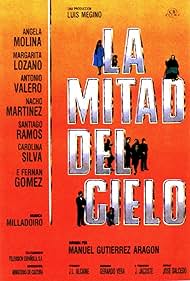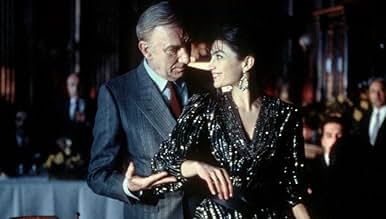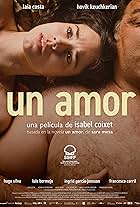Rosa is an cantabrian woman who travel to Madrid after the Civil War. With the help of Don Pedro, a chief supplies, she opens a restaurant that transforms in a political and intelectual cent... Read allRosa is an cantabrian woman who travel to Madrid after the Civil War. With the help of Don Pedro, a chief supplies, she opens a restaurant that transforms in a political and intelectual center.Rosa is an cantabrian woman who travel to Madrid after the Civil War. With the help of Don Pedro, a chief supplies, she opens a restaurant that transforms in a political and intelectual center.
- Awards
- 7 wins & 8 nominations
Photos
Julia Martínez
- Cuñada de Don Pedro
- (as Julita Martínez)
- Director
- Writers
- All cast & crew
- Production, box office & more at IMDbPro
Storyline
Did you know
- ConnectionsFeatures ¿Dónde vas, Alfonso XII? (1959)
Featured review
Enjoyable Manuel Gutierrez Aragón film with good cast and including gorgeous outdoors from Valley of Pas , Cantabria
Rural and urban drama set in wonderful landscapes and starred by Spanish all-star-cast , such as Angela Molina , Fernando Fernán Gómez , Santiago Ramos , Antonio Valero and being well directed by Manuel Gutierrez Aragon . It deals with Rosa's life (Angela Molina) from her adolescence at a village in Cantabria region to the sixties in which she triumphs in Madrid , ruling a great restaurant . In Valle De Pas , Rosa lives with her parents (Raul Freire , Concha Hidalgo) and siblings (Enriqueta Carballeira , Mercedes Lezcano) . But Rosa flees from her sad home and goes to the capital , Madrid . At the beginning , Rosa gets a stand at the market where sells tripe , sweetbread , liver , kidney , tongue and other guts . A bit later on , with the help of Don Pedro (Fernando Fernán Gómez) , a chief supplies , she opens a restaurant that transforms in an intellectual and political center .
The brilliant first part is set in Valle De Pas , next to Torrelavega , Cantabria , North of Spain , with little dialogue and narrative ellipsis . Here several characters are presented , the stiff-upper-lip father , the haunting grandmother , and her future husband : Santiago Ramos , who goes into prison . The second part describes how Rosa arrives in Madrid as maid of the wealthy Don Pedro , magnificently played by Fernando Fernan Gomez , as always . This interesting film deals with thought-provoking drama of human emotions crammed with social habits , family relationship and love stories . Its style is pretty much agreeable and realistic as well in the atmosphere as in the fresh dialog , but also including magical elements as when the deceased grandmother appears . This film describes the rural life , including a character studio of local people along with their lives in the big city with markets , shops and restaurants ; however , it relies heavily on Rosa's family relationships . The picture belongs to Manuel Gutierrez Aragon's trilogy , formed by : 1ª : ¨Demonios En Jardín¨ (1982) , 2ª : ¨Mitad Del Cielo¨ (1986) or ¨Half of Heaven¨ and 3ª : ¨El Rey Del Rio¨(1999) , all of the them concerning about chronicles of the post-Spanish Civil War until the ¨political transition¨ . The film talks about ¨Food¨, as various characters appear eating and preparing vegetable stews , meats , dishes , and other stews . Well played by known and notorious actors such as Angela Molina playing a Cantabrian woman who travels to Madrid after the Civil War to get a great triumph and Fernando Fernán Gómez steals the show as old supplies chief who falls in love for Rosa . Support cast is frankly good , such as Margarita Lozano as mysterious grandmother , Paula Molina as a teen of lurid imagination , Raul Freire as a grumpy father who pulls off coercing methods , Nacho Martínez as stiff public official and Francisco Merino as likable shopkeeper . Good production design by Jose Luis Cerezo , correctly reflecting the atmosphere by that time and location . Evocative gowns by expert costumer Gerardo Vera . Splendid photography with juicy atmosphere by the prestigious Jose Luis Alcaine . Alcaine was first cinematographer to use fluorescent tube as "key" lightning and deemed to be one of the best Spanish cameramen . Alcaine frequently works with Pedro Almodóvar , Bigas Luna and Vicente Aranda , he has photographed a lot of successes . Being appropriately filmed on location , showing one colorful filming from Valle De Pas , Cantabria , North of Spain . Traditional and folklorist score by a great folk band , Milladoiro . The picture won numerous prizes such as Fotogramas De Plata 1987 to Best Film , Best Movie Actor : Fernando Fernán Gómez ; Goya Awards 1987 to Best Movie Actress : Angela Molina , Best Cinematography : José Luis Alcaine , Best Costume Design : Gerardo Vera ; San Sebastian International Film Festival won Golden SeaShell : best filmmaker and best actress .
The motion picture perfectly produced by magnificent producer , Luis Megino (also screenwriter) was compellingly written and directed by Manuel Gutierrez Aragon , a good Spanish movies director . Manuel Gutiérrez Aragón was born on January 2 , 1942 in Torrelavega , Cantabria, where uses to set most of films , including Valley Pas . He is a writer and director, known for Habla, Mudita (1973) , Camada Negra (1977) , Maravillas (1981) , Demonios en el Jardín (1982) , Feroz (1984) , Visionarios (2001) , Todos Estamos Invitados (2008) . He began working in cinema in 1973 when he filmed ¨Habla Mudita ¨ , this debut feature by acclaimed Spanish director deals with a strange relationship between a mature men and a mute villager and also set in rural country from Valley Pas . Manuel Gutierrez is a well recognized filmmaker both nationally and internationally, and in proof of it he won many prizes among which there are the following ones : David di Donatello Awards , Moscow International Film Festival , and San Sebastian International Festival award to ¨Demonios en Jardin¨ , Goya Awards 1987 to ¨La Mitad del Cielo¨ , Cinema Writers Circle Awards, Spain and Berlin Internation Festival 1996 to ¨Rey del Rio¨ , Biarritz International Festival awards and Goyas 2003 to ¨Caballero Don Quijote¨ , among others .
The brilliant first part is set in Valle De Pas , next to Torrelavega , Cantabria , North of Spain , with little dialogue and narrative ellipsis . Here several characters are presented , the stiff-upper-lip father , the haunting grandmother , and her future husband : Santiago Ramos , who goes into prison . The second part describes how Rosa arrives in Madrid as maid of the wealthy Don Pedro , magnificently played by Fernando Fernan Gomez , as always . This interesting film deals with thought-provoking drama of human emotions crammed with social habits , family relationship and love stories . Its style is pretty much agreeable and realistic as well in the atmosphere as in the fresh dialog , but also including magical elements as when the deceased grandmother appears . This film describes the rural life , including a character studio of local people along with their lives in the big city with markets , shops and restaurants ; however , it relies heavily on Rosa's family relationships . The picture belongs to Manuel Gutierrez Aragon's trilogy , formed by : 1ª : ¨Demonios En Jardín¨ (1982) , 2ª : ¨Mitad Del Cielo¨ (1986) or ¨Half of Heaven¨ and 3ª : ¨El Rey Del Rio¨(1999) , all of the them concerning about chronicles of the post-Spanish Civil War until the ¨political transition¨ . The film talks about ¨Food¨, as various characters appear eating and preparing vegetable stews , meats , dishes , and other stews . Well played by known and notorious actors such as Angela Molina playing a Cantabrian woman who travels to Madrid after the Civil War to get a great triumph and Fernando Fernán Gómez steals the show as old supplies chief who falls in love for Rosa . Support cast is frankly good , such as Margarita Lozano as mysterious grandmother , Paula Molina as a teen of lurid imagination , Raul Freire as a grumpy father who pulls off coercing methods , Nacho Martínez as stiff public official and Francisco Merino as likable shopkeeper . Good production design by Jose Luis Cerezo , correctly reflecting the atmosphere by that time and location . Evocative gowns by expert costumer Gerardo Vera . Splendid photography with juicy atmosphere by the prestigious Jose Luis Alcaine . Alcaine was first cinematographer to use fluorescent tube as "key" lightning and deemed to be one of the best Spanish cameramen . Alcaine frequently works with Pedro Almodóvar , Bigas Luna and Vicente Aranda , he has photographed a lot of successes . Being appropriately filmed on location , showing one colorful filming from Valle De Pas , Cantabria , North of Spain . Traditional and folklorist score by a great folk band , Milladoiro . The picture won numerous prizes such as Fotogramas De Plata 1987 to Best Film , Best Movie Actor : Fernando Fernán Gómez ; Goya Awards 1987 to Best Movie Actress : Angela Molina , Best Cinematography : José Luis Alcaine , Best Costume Design : Gerardo Vera ; San Sebastian International Film Festival won Golden SeaShell : best filmmaker and best actress .
The motion picture perfectly produced by magnificent producer , Luis Megino (also screenwriter) was compellingly written and directed by Manuel Gutierrez Aragon , a good Spanish movies director . Manuel Gutiérrez Aragón was born on January 2 , 1942 in Torrelavega , Cantabria, where uses to set most of films , including Valley Pas . He is a writer and director, known for Habla, Mudita (1973) , Camada Negra (1977) , Maravillas (1981) , Demonios en el Jardín (1982) , Feroz (1984) , Visionarios (2001) , Todos Estamos Invitados (2008) . He began working in cinema in 1973 when he filmed ¨Habla Mudita ¨ , this debut feature by acclaimed Spanish director deals with a strange relationship between a mature men and a mute villager and also set in rural country from Valley Pas . Manuel Gutierrez is a well recognized filmmaker both nationally and internationally, and in proof of it he won many prizes among which there are the following ones : David di Donatello Awards , Moscow International Film Festival , and San Sebastian International Festival award to ¨Demonios en Jardin¨ , Goya Awards 1987 to ¨La Mitad del Cielo¨ , Cinema Writers Circle Awards, Spain and Berlin Internation Festival 1996 to ¨Rey del Rio¨ , Biarritz International Festival awards and Goyas 2003 to ¨Caballero Don Quijote¨ , among others .
Details
Contribute to this page
Suggest an edit or add missing content


























